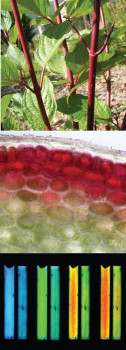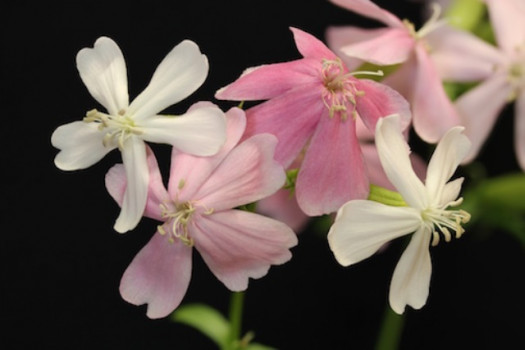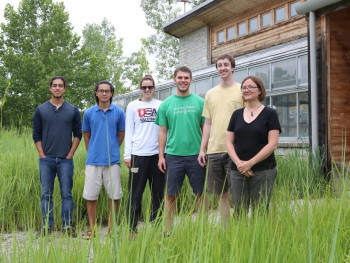pigments, stress and red stems

Bouncing Bet

Background
I wanted to be a biologist since Grade 6 when I first saw a scientist give a slide show at my school… from early on, I knew I wanted to be a researcher but it took me a while to figure out what kind of science I wanted to do. In college, I worked on a few projects investigating the evolution and ecology of flowering plants, and I have been doing that ever since.
I came to DePauw in 1999 after completing my Ph.D. examining the genetics and ecology of sex determination in a native Indiana wildflower. These days, I enjoy working with all kinds of students who are willing to ask observe the world and ask questions from the plants’ point of view. Usually my students and I study how plants change physically and chemically in response to environmental stress.
STUDENT COLLABORATION
I collaborate with DePauw students on almost all of my research projects, and students often have a voice in designing the experiments we perform. I have worked with dozens of students who have gone on to have careers from surgeons to botanists to National Park rangers.
Summer student-faculty research at DePauw gives students a chance to feel how research really works on a full-time basis – from the creative parts involved in project design (Hey, could we study this? How?), to the utterly tedious parts (Whose idea was it to grind up 650 flower parts into little tubes?). We have a good time and get a lot done.
Lines of Research
-
INTEREST A - (ONGOING) Why does bouncing bet blush? Evolution and ecology of floral color change in Saponaria officinalis
-
INTEREST B - (ONGOING) Primary succession and community rehabilitation in an abandoned limestone quarry
-
INTEREST C - Plant pigments and environmental stress
-
INTEREST D - Sex and gender in plant biology and feminist theory
Why does Bouncing Bet Blush? (ONGOING)
Floral color variation in Saponaria represents a classic biological problem: how does variation persist in the face of natural selection? Individual flowers of bouncing bet (Saponaria officinalis) change color, from white to pink, as they develop. Our team has demonstrated that a plant’s physical environment, as well as its genetic background, contribute to the amount of pigment its flowers produce. We also discovered that pollinators preferentially visit white flowers when given a choice between white and bright pink flowers. Now we are wondering why the flowers continue to turn pink even when it seems to be bad for their reproduction.
STUDENT COLLABORATION
 Every year, we form Team Saponaria, a group of DePauw students and faculty who work with a group of faculty and students at University of Indianapolis. The cross-campus collaborations led by me and Dr. Sandra Davis at UIndy are always fun and productive!
Every year, we form Team Saponaria, a group of DePauw students and faculty who work with a group of faculty and students at University of Indianapolis. The cross-campus collaborations led by me and Dr. Sandra Davis at UIndy are always fun and productive!
RELATED PUBLICATIONS
In this article from Team Saponaria in 2013, five students*, my collaborator Sandy Davis and I demonstrated that pollinators discriminate against pink flowers, and that male- and female-phase flowers have substantially different color, size, and shape in this species.
Citation: Davis, S. L., D. A. Dudle, J. R. Nawrocki*, L. M. Freestone*, P. Konieczny*, M. B. Tobin*, and M. M. Britton*. 2014. Sexual dimorphism of staminate- and pistillate-phase flowers of Saponaria officinalis (Bouncing bet) affects pollinator behavior and seed set. PLoS ONE 9(4): e93615. doi:10.1371/journal.pone.0093615
Download PDF
http://journals.plos.org/plosone/article?id=10.1371/journal.pone.0093615
primary succession and Community rehabilitation of an abandoned limestone Quarry
Several students and I are taking the initial steps toward a long-term project of establishing a native plant community similar to limestone cedar glades in the limestone quarry at the DePauw Nature Park. We love the idea of using this human-scarred landscape as a habitat that may support rare Indiana native plants.
In a related project, my Conservation Biology students and I have been mapping the spread of an invasive plant, Phragmites australis in the Quarry for over 10 years. Our data suggests that, without intervention, invasive plants will continue dominate the harsh landscape of the quarry bottom.
PUBLICATIONS FROM PAST PROJECTS
-
I collaborated with several students* and Dr. Bryan Hanson (DePauw Chemistry & Biochemistry) to describe genetic and environmental variation in the chemical responses of the stress-tolerant plant Portulaca oleracea to extreme salt stress.
Citation: Mulry, K.R.*, B.A. Hanson, and D.A. Dudle. 2015. Alternative strategies in response to saline stress in two varieties of Portulaca oleracea (Purslane). PLoS ONE 10(9): e0138723. doi:10.1371/journal.pone.0138723
Download PDF
-
In collaboration with Dr. Kevin Gould (Victoria University, New Zealand), I investigated hypotheses for why so many stems turn red when exposed to environmental stress. It turns out the red pigment shields the stems’ chloroplasts from oxidative damage caused by excess light.
Citation: Gould, K.S., Dudle, D.A., and Neufeld, HS. 2010. Why some stems are red: Cauline anthocyanins shield photosystem II against high light stress. Journal of Experimental Botany 61(10): 2707-2717.
Download PDF
How does research influence Teaching at DePauw?
My research has powerfully influenced my teaching, and vice versa. As an experimentalist, I feel a responsibility to help my students in the classroom learn to design rigorous studies, identify and test their assumptions, and communicate their findings clearly. In my lower-level classes such as Plant Biology, students design short-term studies, and in my upper-level classes such as Conservation Biology students spend much of the semester designing and carrying out original research projects. And sometimes those independent projects morph and grow into long-term studies my research group can investigate for years. DePauw is a great place for my teaching and research to interact in productive ways, in the lab and in the field.